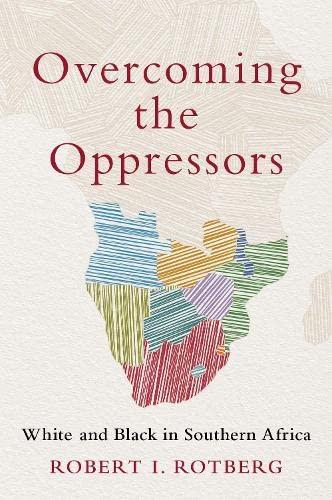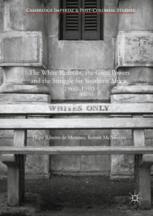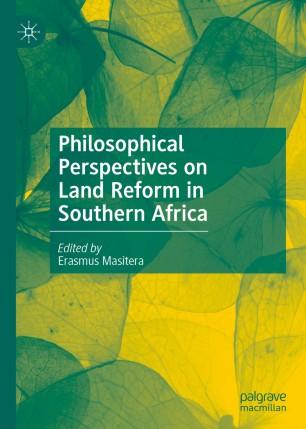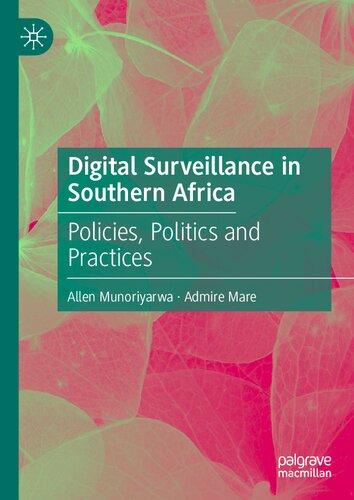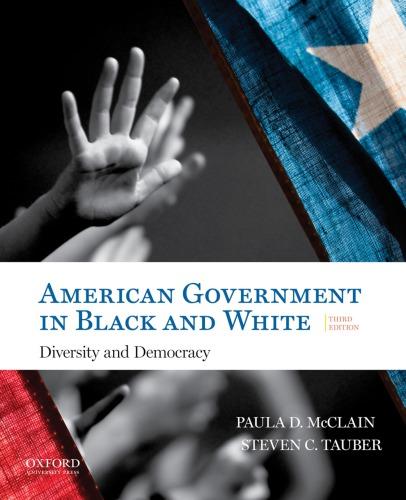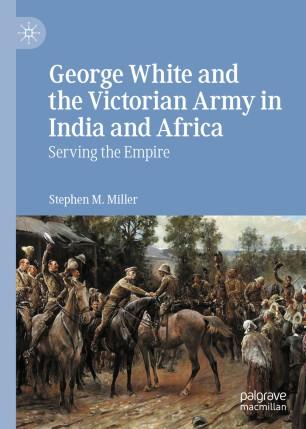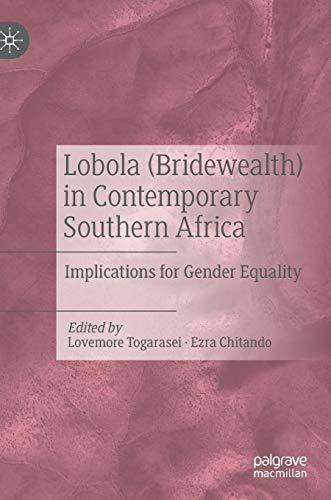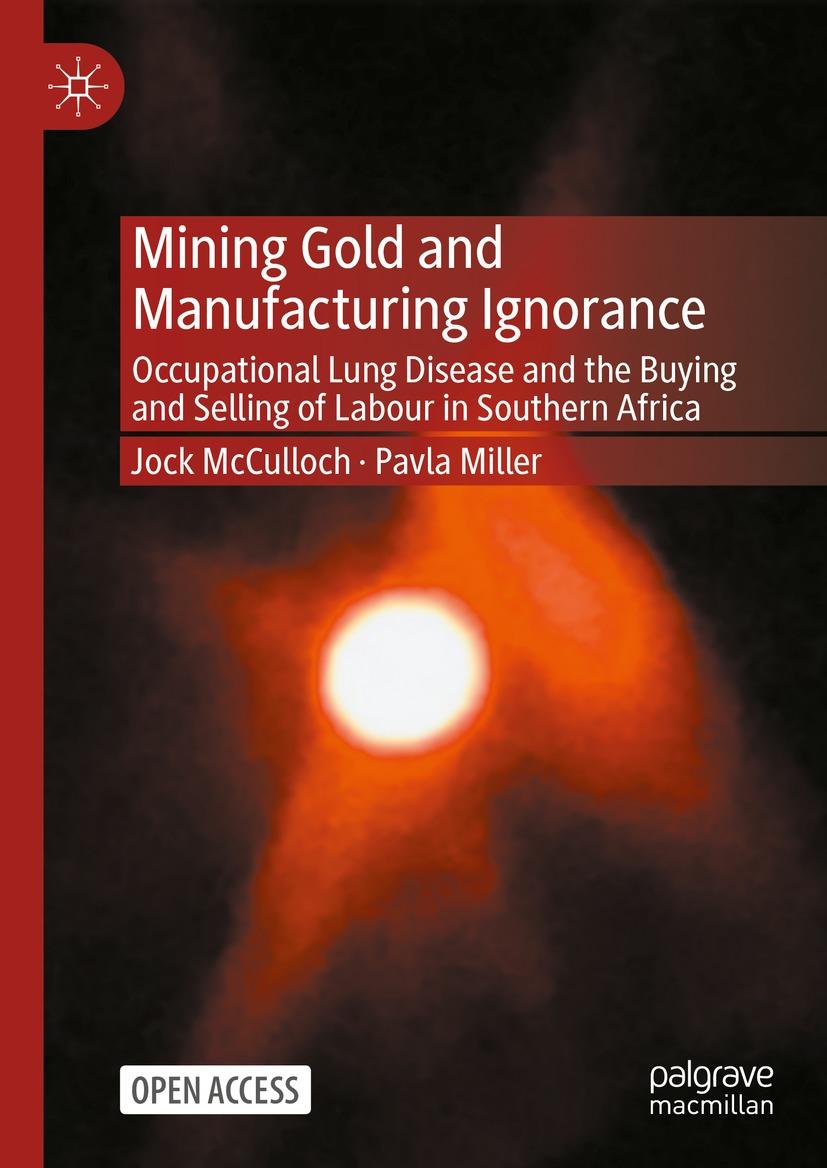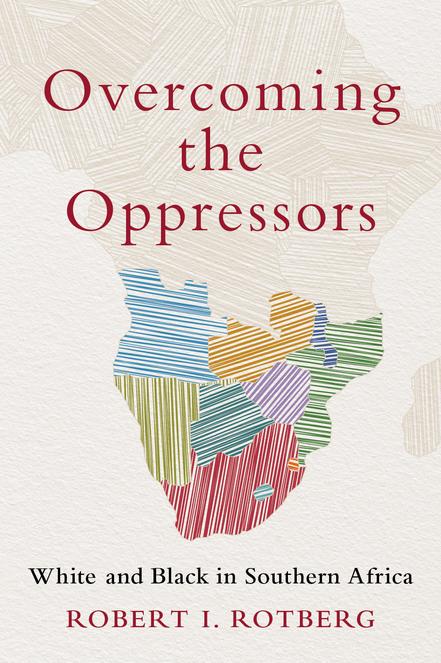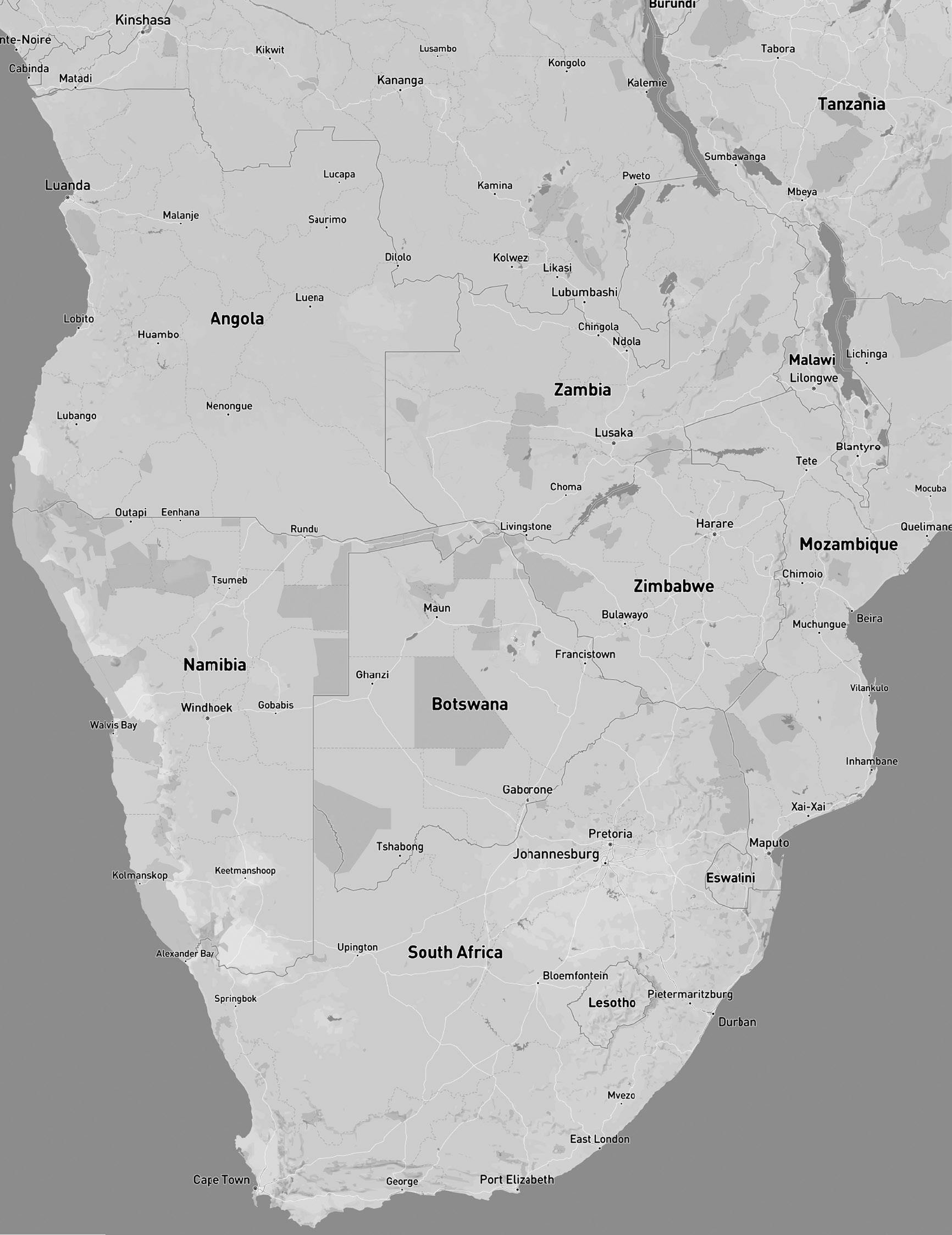Illustrations
By Joanna G. Cloutier
By Dylan A. Gattey
1.1. Southern Africa
2.1. Zambia and Malawi
6.1. South Africa and Botswana
9.1. Zimbabwe and Botswana
10.1. Botswana and Namibia
Preface
Te countries of sub-Saharan Africa have ruled their postcolonial selves for many decades. Te Sudan shed the constraints of an Anglo-Egyptian condominium to become an independent nation in 1956. A year later, President Kwame Nkrumah turned the Gold Coast into Ghana, energizing and emboldening many of the aroused populations of Africa’s remaining British, French, Belgian, Portuguese, and Spanish colonial possessions and trust territories to agitate for their own liberation.
In southern and eastern Africa, where entrenched white settler elites joined standard-issue British colonial administrators in governing disparate territories, the process of decolonization took much longer than in West Africa. As the Algerian war against France raged along the Mediterranean shores, so Africans from central Kenya in the 1950s attacked settlers and British installations. Farther south, afer indigenous civil protests failed to halt the imposition of a white-dominated Federation of Rhodesia and Nyasaland, Africans turned violent and, under determined new leadership legitimized by months in prison, in 1964 transformed Northern Rhodesia into Zambia and Nyasaland into Malawi. Peacefully, Bechuanaland emerged as Botswana in 1966, just as Tanganyika had amicably gained its independence in 1961 (eventually as Tanzania in 1964). Both places had relatively few white residents. Nor were white numbers an impediment to nationhood when the Crown Colony of Basutoland became Lesotho in 1966 and monarchical Swaziland (now Eswatini) followed suit in 1968.
Tose contested and little-contested exits from British colonial oversight lef the much more heavily populated white redoubts at the end of the continent under the tight-fsted control of minorities. Afer an increasingly bitter civil war, white settlers were next eased out of power in Zimbabwe by African antagonism and British diplomacy in 1980. Namibia, which South Africa had incorporated into its own territorial domain in defance of United Nations’ rulings, was the locus of another struggle until the demise of the Soviet Union and skilled American diplomatic intervention caused South Africa to give way to a United Nations electoral exercise and, in 1990, to convey Namibia to independence. (Te Lusophone territories of Angola and Mozambique were fought over by colonial rulers and liberation movements until the Portuguese dictatorship was overthrown from within in 1974, leading to the emergence of both new African nations in 1975. Tereafer, both countries harbored anti–South African and
anti-Rhodesian guerrilla bases, assisting cross-border operations for freedom in neighboring Zimbabwe and Namibia, and also against distant South Africa.)
Whites in South Africa were much more numerous than they were in Kenya, the Rhodesias, or Namibia. Tey had governed themselves and their majority African, Coloured, and Asian subject peoples for eighty years before African internal unrest and external attacks, combined with outside fnancial pressure, fnally forced white hegemonists to release famed political prisoners from prison and negotiate a peaceful transfer of power.
Te Long Walk to Freedom
Tis book is about southern Africa’s long walk to freedom, about the overturning of colonial rule in the northern territories and the dissolution of backs-to-thewall white settler suzerainty frst in what became Zimbabwe and then in South Africa. Chapters on the individual countries detail the stages along their sometimes complicated and tortuous struggle to attain the political New Zion. We learn how and why the Federation of Rhodesia and Nyasaland failed, how and why apartheid eventually collapsed, and exactly how the various components of this heavily white-conquered and later white-oppressed domain transitioned via diverse fts and starts into today’s assemblage of proud, politically charged, and still mostly fragmented nation-states.
But what did the new republics make of their hard-won freedoms? Tat is the subject of more than half of this book. Having liberated themselves successfully, several soon dismantled democratic safeguards, established efective single-party states, closed their economies, deprived citizens of human rights and civil liberties, and exchanged economic progress for varieties of central planning experiments and stunted forms of protected economic endeavors. Only Botswana, of the new entities, embraced full democracy and good governance. Te others, even South Africa, at frst tightly regimented their economies and attempted severely to limit the degrees of economic freedom and social progress that citizens could enjoy.
Largely because of its emphasis on delivering high-quality and abundant quantities of positive governance, a result of remarkable political leadership, Botswana prospered steadily from independence until today; it became the most successful (across several dimensions) of all mainland African countries and a tribute to the remarkable political culture that its frst president introduced, nurtured, and elaborated.
Botswana achieved its spiritual and material advance in part because achieving good governance meant putting the public interest of citizens before a leader’s ethnic or family interests, and well ahead of personal preferences and concerns.
Te second half of this book examines the many ways in which leadership elsewhere in southern Africa was ofen defcient, self-serving, and neglectful of the needs of large groups and numbers of citizens. It shows how almost everywhere except Botswana, presidents followed presidents who solemnly promised to uplif their nations and their constituents, and fell far short of their own declared aspirations.
In every section of southern Africa except Botswana, ruling political elites became greedy. Tey indulged in manifold varieties of corruption: procurement over-invoicing with kickbacks, large-scale bribe taking in exchange for concessionary opportunities for plunder, play for pay, pay for jobs, the wholesale thef of payrolls, enrolling ghost employees, the appropriation of public resources for private enrichment, straightforward embezzlement, and even the purchase of privately consumed goods with state funds. In fact, as this book shows, corrupt actions and behavior strew boulders across the highways of progress, preventing many of the new countries (even South Africa) from delivering essential political goods like schooling and electric power to their loyal, underprivileged, and endlessly enduring constituents.
Te New Rulers
Chapters in this book hence examine what the new rulers of southern Africa did with their hard-won patrimony. Te chapters reveal how in some cases outgoing oppressors were succeeded by new manifestations of oppression. In 2022, the presidents of South Africa, Malawi, and Zambia were each attempting to scrub their countries of the blemishes lef by previous presidential regimes and excesses. Te new leadership in several other countries was busy undoing—or at least attempting to undo—the errors of their predecessors.
Fortunately, southern Africa is on the mend. Tis book is thus about how the southern African nations of today are attempting to recover from earlier vicissitudes and egregiously self-indulgent forms of leadership. New leaders are overcoming latter-day oppressors. Even Botswana contends with new kinds of internal struggles, just as South Africa’s key areas of consternation are both within the ruling political party and between the African National Congress and its rivals.
Te book’s concluding chapter weaves these separate but interlocked national stories into an analysis of the contribution of good leadership to southern Africa’s growth, to sub-Saharan Africa maturity more generally, and to improved conditions and the alleviation of poverty in most countries. Indeed, every chapter describes how responsible or self-absorbed leadership infuenced the ways in which each state dealt with its post-colonial challenges and opportunities, and
how well. Te conclusion assesses the extent to which the peoples of southern Africa have been served well by their leaders and what may now be done to strengthen the leadership factor in this and future decades. Te conclusion discusses the impact of the coronavirus pandemic on southern Africa, and what it has meant and will mean. Tat last chapter also sets out the litany of challenges ahead—vexing ones that each nation will need to confront if southern Africa is to take its rightful place as a beacon of prosperity and good governance within Africa and the world.
Tis book is an analytical narrative throughout. It is prescriptive. It is informed by my own personal observation of, engagement with, and contemporary commentary on much that transpired in southern Africa from 1959 to 2022. I was close to the action on many telling occasions, and carefully followed the political, economic, and social developments that afected the peoples of southern Africa as they liberated and commenced to rule themselves. Hence this book is in signifcant parts about peoples whom I know and respect and leaders with whom I have interacted over considerable time. It refects, too, my abiding interest in securing uplifing outcomes for the disparate peoples of southern Africa—peoples who have too ofen been neglected by ambitious political elites. Tere is much to be done, and too little time to accomplish all that now remains on southern Africa’s ambitious agenda of modernization.
R. I. R. June 17, 2022
1 “Partnership” and Multiracialism in the New Africa
Sub-Saharan Africa in the late 1950s and early 1960s was thoroughly contested, exciting, vibrant, and—for an embryonic researcher eager for knowledge and intellectual as well as political adventure—ripe for social scientifc exploration. Te sub-continent was in ferment; colonial rule was obviously threatened, but not necessarily in full fight. Nationalism was the cry of the day, thanks to successful devolutions of power in the Sudan and Ghana, in Guinea, and shortly in the remainder of francophone West and Central Africa and the ex-B elgian Congo. Te Mau Mau rebellion in Kenya was in retreat, too, but colonial rulers were uniformly anxious to avoid similar kinds of militant protests elsewhere in their farfung imperial domains.
Te old order was giving way, and the young researcher out from Oxford arrived fortuitously amid the tumult with a natural afnity for the underdog— for those teachers, clerics, and shopkeepers who were challenging the established order and seeking a new dawn and the gaining of full democracy for themselves and their long subservient and (in many cases) oppressed brethren. Nowhere in this era was the need for new dispensations and (radically) novel solutions more necessary and more adversarial in 1959 and 1960 than in southern Africa. Te juggernaut of white-devised and white-enforced brutal segregation (apartheid) anchored the end of the continent.
Wrapped to some degree around South Africa’s northernmost province were the African protectorates of Swaziland (Eswatini) and Bechuanaland (Botswana), and white-run Southern Rhodesia (Zimbabwe). Te last (locally governed) country was in turn linked ofcially to its northern and African neighbors, Northern Rhodesia (Zambia) and Nyasaland (Malawi), African British protectorates with copper mines, tea plantations, and white settlers and white mine-workers of some duration. Te last three unlikely bedfellows had been yoked together by Britain in 1953 as the Federation of Rhodesia and Nyasaland over the vehement protests of Africans of all classes and backgrounds in the northern protectorates and in Southern Rhodesia, and to the great applause of conniving, greedy, white planters and industrialists in the colony.
Tis was the bitterly contested setting for my introduction to Africa and its political conficts. Despite African concern and opposition, much of the British
Overcoming the Oppressors. Robert I. Rotberg, Oxford University Press. © Oxford University Press 2023. DOI: 10.1093/oso/9780197674208.003.0001
political establishment, even a smattering in the academy, and some wellintentioned Americans, viewed the Federation as a bold experiment in multiracial partnership, linking white and black harmoniously in a manner capable in theory of halting the spread of odious apartheid northward into white-run Southern Rhodesia while simultaneously avoiding the dangers of “premature” African rule and mayhem of the Mau Mau variety in the protectorates. Te
Map 1.1. Southern Africa
knowledgeable and liberal Britons who had helped to engineer the Federation, push it through Parliament afer bargaining with the whites of the Rhodesias, and defly snub South Africa by snatching Bechuanaland and Swaziland (and Basutoland) from the clutches of apartheid, congratulated themselves on a clever maneuver that would help to give much of southern Africa an opportunity to modernize and develop without inter-communal strife. Te plan was to let white rule by entrenched settlers and mine-workers gradually “uplif” the larger mass of less well-educated Africans. Northern Rhodesia’s copper riches would support the new edifce, support the otherwise impecunious Africans of the protectorates (and of Rhodesia), and subsidize the weak economy of Southern Rhodesia while Southern Rhodesia in turn supplied (white) managerial talent to the entire Federal enterprise.1
Te partners would evolve. At frst the junior partners would remain junior, but gradually they would help to oversee their own destiny politically as they gained in economic parity. In this manner, reckoned Whitehall and the Southern Rhodesian and Northern Rhodesian (white) political establishments, the settlers would remain content and proft, and Africans would—over decades—share the benefts that were bound to accrue to such a Machiavellian arrangement. And African nationalism—African representative home rule—would be sidestepped for a long time, possibly forever.
Even from my limited prior knowledge before landing in the heart of the Federation in very early 1959, I knew that such a runaround was unlikely to provide anything of value to the African populations of the three Federal component territories (more than 2.5 million Africans in each territory, with only 223,000 whites in Southern Rhodesia, 76,000 in Northern Rhodesia, and 9,000 in Nyasaland). I understood, too, that Africans in all three components had voiced overwhelming opposition to the Federation, and that there were some prominent local liberal whites declaiming that the Federation was less a sensible experiment than a thoroughgoing sellout to settler interests. But I could not have known (nor could others) as I walked of a lumbering propeller aircraf afer an eighteen-hour journey to Harare from London, exactly how the Federal question was going to be resolved and how I was going to participate as a researcher in its dissolution and the political convolutions that ensued.
As a young doctoral student in a distant and unfamiliar land, I could not have been more energized, more open-eyed, more concerned to learn everything there was to learn about British Central Africa, and to write about its new and upcoming insurgents both as a budding scholar and as a sometime stringing journalist for the New York Times. (I had been employed by the New York Times in New York before going up to Oxford. From Oxford I contributed articles to the newspaper via its London bureau. In Africa I was the proud possessor of a
Times telex account, so could fle stories occasionally from Zambia and beyond. Te Times then had no correspondent in Africa.) Te moment was very ripe for inquiry, learning, and engagement.
Along the Cairo Road
Based for that frst year in Africa at Zambia’s premier, still colonially run, research institute at the edge of what was still a sleepy national capital of 82,000, I quickly set about gleaning everything I could about the kidney-shaped future nation, then of 3 million, now 18 million, people. Tere were three urgent tasks: (1) to try to explore the entire country (11 percent larger than Texas and roughly equivalent to the size of France, Spain, and the Low Countries) during my allotted year away from Oxford so that I could begin to appreciate how its diferent peoples and regions interacted with each other, and formed the whole; (2) to investigate throughout the Protectorate how colonial rule and accompanying Christian missions (Zambia then had a remarkable number of distinct churches and sects operating mission establishments across the length and breadth of the country) infuenced indigenous Zambians for good and ill; and (3) to grasp the political diferences that (how much I hardly imagined at the beginning) were about to rend the country’s colonial legacy and create a virile indigenous drive to independence.
Lusaka, the capital of the Protectorate only since 1935, was originally merely a station on the sole rail line, half way between Victoria Falls and the old capital of Livingstone and Ndola and Kitwe, the chief mining towns of the Copperbelt. Zambia then was one of the three largest copper producers in the world. Copper ore provided 97 percent of the nation’s and about 75 percent of the Federation’s export earnings. Te rail line carried copper ore south from the Copperbelt through Botswana and South Africa to freight terminals in Port Elizabeth (now the Nelson Mandela Bay Metropolitan Municipality) on the Indian Ocean, and thence to the United Kingdom, the United States, Japan, and other overseas consumers and fabricators.
Alongside the rail line that drove straight through Lusaka’s commercial center, with its many small white- and Indian-owned shops, its larger depots for maize, and scattered ofce buildings, was the Cairo Road, the city’s sole paved artery. Named that way to acknowledge Cecil Rhodes’ dream of a British transportation route from Cape to Cairo, the tarmacked road carried automobiles and trucks beyond Lusaka in northern and southern directions. But to go east, past my institute and the country’s best high school, and onward to distant Malawi, vehicles traversed gravel. And to the west, toward the far-distant Kafue and Zambezi Rivers, and the semiautonomous state of Barotseland, the tracks were
largely composed of scraped and packed earth, muddy and dangerous during the yearly rains.
Eventually, I managed to visit every corner of Zambia, even evangelical mission stations near the headwaters of the Zambezi River adjacent to Angola and extremely isolated Roman Catholic outposts located near the same mighty river—but separated by 684 miles—nestled near Mozambique. I went back and forth on the Great East and Great North Roads, went west carrying big drums with the fuel required to attain remote Mongu and Sesheke en route to the border with Angola, traveled far of the usual beaten paths to see the second longest uninterrupted waterfall in Africa—a narrow plunge of 772 feet called Kalambo Falls, near Lake Tanganyika, and made several journeys into the Gwembe Valley alongside the lower Zambezi River to observe how callously Federal and colonial ofcials were ousting 30,000 Tonga villagers to make room for the lake (280 km long) that would form behind the mighty Kariba Dam, completed on my watch in 1959. On the Copperbelt I went underground, to the deepest point in the Mufulira mine, to try to understand how ore was dynamited and collected, and to observe the obscenely difcult conditions under which African miners labored.
Tere was much to see and peoples of seventy diferent linguistic groups and four dominant ones to meet and to understand and appreciate. Tere were chiefs and missionaries to interview; district commissioners and their assistants to accompany on their journeys in order to learn how the colonial system ran itself and governed its protected charges; local students and others to travel with and learn from, especially when they were within their home provinces; and villagers who took us in, miles from the line of rail.2
Quickly, too, I realized that Africans were mobilizing against Federal rule, and against colonial oversight, much more forcefully and determinedly than had been reported to me in Britain and the United States. Zambians (and Malawians) were agitating with a new fervor for freedom. Te African townships around Lusaka and elsewhere in Zambia were embracing nationalism and independence in new ways. Te colonial and Federal authorities were becoming increasingly nervous. More than once I was summoned to the ofce of the colonial secretary for native afairs in Northern Rhodesia (the third ofcial afer the governor) and instructed to pay strict attention to my doctoral research on missions only and to cease involving myself (even as an observer) in politics. Essentially, I was told forcefully to stop meddling.
But even by the time (Sir) Glyn Jones (later governor of Malawi and member of the Pearce Commission in Zimbabwe, and someone I subsequently came to know well) tried to warn me away from studying political evolution, hardly anyone aware of the depths of African discontent could avoid being captured by the promise of gifed new leadership and the prospect of transformational change.
Within days of my January arrival in Lusaka, it was clear to me and to others that Africans were challenging authority and demanding rights in ways that were new, provocative, and inspirational. No longer could Britain’s Colonial Ofce remain complacent.
Te governor of the nascent Zambia, together with his colonial civil servants and a cadre of mostly Oxbridge trained district commissioners and their mostly white and some black assistants, provided the core of “native” administration. Tis was a tidy and largely inefcient but somehow efective way of governing colonial territories. Te district commissioners, each responsible for a rural collection of chiefdoms and villages, collected taxes, arbitrated disputes, prosecuted and tried local ofenders, and projected a kind of British imperial “rightness” over the indigenous terrain. Tis method and its rationale was reasonably well accepted in rural Zambia especially since, to some degree, the district commissioners ruled together with indigenous chiefs, many of whom prospered alongside the foreign administration.
But the urban areas, growing in size and importance, were less content with an absence of real political participation under foreign governance. Urban residents throughout the colonies were better educated, more aware, and with broader horizons than their rural counterparts. Tey appreciated the fact that Ghana and the Sudan had already achieved independence. Tey resonated with the grievances of Kenya and had many of their own. Some well-traveled Zambians had been to India or knew details of Mohandas K. Gandhi’s successful struggle against British domination in India (and what he had failed to accomplish earlier in South Africa).
Te missionaries in Zambia had also instructed well. Te more liberal denominations, such as the United Free Church of Scotland, the British Wesleyan Methodists, and the Church of England, had been teaching their communicants to value individual freedom and initiative, to deprecate any limitations on human freedom, and to value the humane teachings of the Gospel. Tose messages penetrated deeply into the Zambian consciousness. Many Africans schooled and catechized by liberal missionaries naturally came to want the same rights as whites and believed that they deserved them, especially in their own country.
White Zambians helped to rule the territory through an elected national assembly called the Legislative Council (Legco). By 1959, afer decades of devolution, it had a strong say in making laws and running the territory. Te governor still had the fnal word, but he and the other “ofcials” largely tried to avoid confict with Legco and its white leaders. Tere had long been an appointed white assemblyperson who nominally represented “native interests,” and four Africans had recently been elected to Legco. In addition, the Federation’s own parliament included two Africans from each of its constituent parts.
At the same time, Zambia’s colonial rulers relied for the articulation of indigenous views as much on the African Representative Council as on subordinate councils established in each of the Protectorate’s provinces. Tese were lively, ofen vigorously argumentative, talking shops. Te administration largely viewed them as expressive outlets, not as core components of the territory’s governing apparatus. Te fact that nearly all of these councils had strongly opposed the creation of the Federation in 1953 had not deterred the Colonial Ofce from foisting the Federal scheme on Africans in the northern lands. Te fact that the indigenous leaders of these councils, and that leaders of the emerging African elites in both territories, had separately and together pleaded with the Colonial Ofce not to yoke their futures to that of Southern Rhodesia had made no diference. Africans, on these grounds alone, felt ignored and abused.
Te Federal Experiment
What was wrong with the Federal experiment? By 1959, it was clear to African opinion in the northern lands, and also in Zimbabwe, that multiracial partnership was a sham, as indigenous spokesmen had long suspected. Africans would, it was envisaged by Federal Prime Minister Sir Godfrey Huggins (later Lord Malvern) and (Sir) Roy Welensky, his successor, in some far-of day play a probably minor part in ruling the Federation and its three components. But for the present and the near future, at least, whites would control the Federal policy levers in their own interest. Africans would not be segregated particularly (although that was still the case in Southern Rhodesia), but their educational and social perquisites would remain inferior to whites. And the existing color bar would remain social policy everywhere; Africans were forced in the Rhodesias to purchase meat from hatches at the back of butcheries, to stand in separate queues at airports, to use diferent entrances to hospitals and administrative ofces, and so on. Budgetary expenditures obviously favored whites despite the fact that the Federal population of 7.2 million was 97 percent African.
Welensky, a bluf, burley, locomotive driver who had earlier been a white political leader in Northern Rhodesia, had openly declared that “partnership” could never mean “equality”: whites would always remain “the senior partner.”3 Huggins, rarely wavering, even laid out his conception in public in 1951 for all to hear: his callous metaphor was a partnership that consisted of a rider and his horse. He went on to say, “[w]e do not pretend there is any equality of partnership at the present time, but the Native has joined the frm and has his foot on the lower rungs of the ladder; he will have to learn the wisdom of trying to help himself.”4 Huggins, a longtime leader of whites in Southern Rhodesia, also afrmed that “Africans are all liars, until they are very much advanced.”5 As Cyril Dunn,
a perspicacious British journalist, later reported afer interviewing Africans in the northern territories, “Te most suitable defnition of ‘partnership’ was: ‘[a] political system existing in a multiracial society where the blacks are kept permanently subservient to the whites and are persuaded that this is not the case.’ ”6 Kenneth Kaunda’s own contemporaneous comment on Huggins, Welensky, and the paradigm of partnership was, “Lord Malvern [Huggins] . . . has . . . never hidden his crude scorn for African opinion. . . . It is to these prophets of apartheid posing, circumspectly, as believers in partnership that the British Government sold us when they imposed the Federation . . . in 1953.”7
Tere was nothing obviously redeeming about the Federal experiment from the African point of view. Admittedly, creating the Federation had blocked any extension of extreme racial politics northward from South Africa, but that had never been much of a reality or a threat, and, although Afrikaners were numerous proportionally in Southern Rhodesia, it had been a “British” self-governing colony since 1923. Admittedly, too, the creation of the Federation probably helped to attract foreign investment; the three sections of the Federation were stronger economically together. Impoverished Nyasaland (Malawi) certainly benefted from Zambian copper revenues being expended on roads and airfelds and other facilities within its territory.
Southern Rhodesia gained the most from the experiment, however, as Huggins knew that it would. With northern copper royalties fnding their way into the Federal exchequer, and with the Federation being administered from Salisbury (Harare) in what became Zimbabwe, it is no wonder that Zambian Africans, especially, felt misused and cheated. Te expression bamba zonke (“grab the lot” or “skim the cream”) was widely used in the north as an epithet for Salisbury’s growth on the back of Zambian sweat equity.
Consistently strong prices for copper helped to build the imposing Kariba Dam athwart the Zambezi River and to supply relatively inexpensive power to both Rhodesias and to the mines. Salisbury came to resemble the sky-scrapered cities of western America. New immigrants, white miners, white (and Asian) shopkeepers, and bankers all grew impressively wealthy. Locomotive drivers like Welensky prospered. Similarly African living standards probably rose, albeit more slowly and more hesitantly than original promises of what the Federal scheme would deliver. Under Federation, Africans saw little improvement in their generally miserable lot, especially when compared to recent white immigrants.
Before going north to Zambia for the frst time, I listened carefully to Julian Greenfeld, successively Federal minister of education, minister of law, and minister of home afairs, and a long-established white political fgure in Southern Rhodesia, when he explained in idealistic terms how the Federal scheme was going to beneft blacks as well as whites. By managing the kind of profcient
operation that Africans could hardly hope to emulate, he said, the Federation was boosting incomes overall, and some (he said “most”) of those rewards were trickling down to the mass of Africans. But he could not cite more than a mere handful of Africans who were rising in the Federal civil service (there were nine in 1959), or who were beginning to lead corporate endeavors. (As Jaspar Savanhu, the most highly placed of those nine Africans in the Federal governing apparatus said when he resigned in disgust in 1962: “I have fnally reached the decision that your government . . . has failed or has no intention of fully implementing the policy of partnership. . . . As matters stand today I feel that my presence among an all-white Civil Service is only tolerated and I feel lonely, a piece of window dressing. . . .”)8 Greenfeld, however, naturally insisted that Africans were well of and that the Federation was an opportunity for whites to create a future British dominion, on the New Zealand and Australian models, with Africans as (subordinate) citizens. Even someone like Greenfeld, the careful and well-modulated antithesis of a rabble-rouser, was content to live out a major exercise in hypocrisy. Te Federation was a con job.
Socially, lip service was paid in the territories and in the United Kingdom to pretense that the Federation was genuinely multiracial and that Africans were going to be treated well. But everyone closely involved, not only aggrieved African elites, understood that it was a charade. By 1959, a broad-based response by all strata of educated and working-class Africans in both Northern Rhodesia and Nyasaland appreciated with alacrity that the whites were conspiring to place Africans frmly under white rule, whatever Britain preferred to the contrary, and calling the result a federation. Even as early as 1948, the Northern Rhodesian African Congress opposed what was happening: “[S]ome people may think that the African does not see clearly the meaning of Federation. We see its meaning and it means to enslave the African.” Moreover, “Te secret of Federation is to subordinate African interests. . . .” Indeed, the Congress continued, “Partnership . . . is a ladder for Europeans . . . to climb on us.” Dr. Hastings Kamuzu Banda, an American-trained physician practicing in London and later president of Malawi, in 1949 wrote in horror together with Harry Nkumbula, a Zambian student at the London School of Economics, that protected Africans had no wish to exchange their status as wards of the British government for that of “slaves” of the settlers. Moreover, Banda predicted that whites would be “advanced in all spheres to the detriment of Africans.” Te British policy of abolishing discrimination was “doomed.”9
Educated, middle-class and working-class African Northern Rhodesians were adamantly opposed. “Te word [partnership] itself has a good sound,” reported Mufana Lipalile to the Northern Rhodesia Western Provincial Council (one of the Protectorate’s regional indigenous talking shops), but when there are two oxen, “one black and one white,” the white one can say, “I must go ahead and
you must come behind me all the time.” “Partnership,” said Donald R. Siwale in Northern Rhodesia, “is only used on lips and papers and not in practice.” (Siwale, a former Church of Scotland mission teacher and government civil servant, also looked forward to the day when Africans would rule Northern Rhodesia, as they already did in Ghana).10
Te Northern Rhodesian African Representative Council petitioned the Secretary of State for the Colonies: “While appreciating the principle of partnership,” its submission read, “it should be clearly understood that the Africans’ home is in Africa, whereas the Europeans can have access to other parts of the British Commonwealth. If opportunities for advancement of our race are denied in Africa, where else . . . shall we be found?”11
In Nyasaland, where James Frederick Sangala had become president of the nationally representative Nyasa African Congress, forty delegates from its ffteen branches confrmed their opposition to the federal scheme and promised that “Nyasas have and will still protest at all costs.”12 In Zambia, the Mporokoso Native Welfare Association voted against federation. So did the Luwingu and Mwenzo welfare associations, the Northern Rhodesian Northern and Western Provincial Councils, and a number of other ofcial and unofcial forums of African opinion.13 (Te provincial councils were government-initiated but African-controlled voices in their local areas, as were the various district welfare associations that existed in both protectorates.) Later in 1951, a special meeting of African delegates from a number of local organizations repudiated “partnership” in any form, any guise. “Ofcials [must be] getting tired of their responsibilities” to think of leaving, they said. Africans were being pawned by His Majesty’s Government. Just aferward, a regular session of the African Representative Council refused even to help Governor Sir Gilbert Rennie to defne “partnership.”14
In 1951, Dauti Yamba and Pascale Sokota, teachers and subsequent politicians, with the knowledge of Northern Rhodesia’s African National Congress, tested partnership by demanding parity of positions with white “unofcials” on the Executive Council of the Northern Rhodesian Legislative Council, to which august body they had both just been appointed. Tey were rebufed. Banda later exclaimed that “partnership” could not be brought to Central Africa by force. “We, the Africans of Nyasaland and Northern Rhodesia, are people.”15 Africans could hardly believe, even as late as 1951, just how cavalierly Whitehall was prepared to strip their rights way and assign their fate to their present and future oppressors.
Even chiefs, such as Bemba senior chief Mwamba and Malawi chiefs Mwase of the Cewa and Philip Gomani of the Ncheu Ngoni opposed partnership and federation. Most members of the Barotseland paramount chief’s council voted against federation.16 “Every African in Northern Rhodesia does not want to be
federated with Southern Rhodesia,” wrote Paul Sikazwe. He explained the sense of his associates graphically: “If a man is given food and he vomits it, can he again eat what he had already vomited? . . . Most of us know that our friends in Southern Rhodesia are slaves.”17
In Northern Rhodesia, the Chinsali African Welfare Association, led at the time by Kenneth Kaunda, Simon Kapwepwe, and Rueben Kamanga, teachers and all later leaders of the new Zambia, rejected federation outright.18
Te Man with the Monocle
It was on one of my several tours of Zambia’s Northern Province—a heartland of dissent and agitation—that I arrived at Shiwa Ngandu (“the lake of the royal crocodiles”)—near Chinsali, to meet, interview, and learn from the accumulated wisdom of Lt. Col. Sir Stewart Gore-Browne, J.P. He had at one time been the leader of the Northern Rhodesian “unofcials”—the white settlers—giving way to Welensky, the rough-hewn former prizefghter. Gore-Browne had subsequently become the representative in Legco for African interests. He was antagonistic to the Federal scheme, very supportive of African nationalist grievances, in favor of giving more political participatory rights to Africans, friendly with Kaunda and Kapwepwe (their homes and mission station were near Shiwa Ngandu), and passionate regarding the components of an honest partnership between white and black.
Yet, Gore-Browne also was a monocle-wearing patrician of mature years who was more settler than most settlers. Afer having frst arrived at Shiwa Ngandu (originally Lake Young) in 1914, he decided that he would make a permanent home there afer returning from shelling Germans on the French front in World War I. He established a plantation where he grew limes for the French perfume market. Lime oil could travel more easily and inexpensively (per value) than some other crops. Shiwa Ngandu was several days’ journey from the line of rail, and lime oil had a chance—slim though it was—of helping to defray the costs of establishing a Tuscan-type manor house with a view of the lake, keeping a medley of servants, eventually supporting a family (and many retainers), and enabling Sir Stewart (as he was to become) to travel back and forth to Lusaka and onward to London.19
Gore-Browne always excelled as an efortless host. As early as 1925, entertaining Sir Herbert and Lady Stanley, the new governor of Northern Rhodesia and his wife, Gore-Browne reported to Dame Ethel Locke-King in London that the evening had been a wild success: “White soup with new asparagus was followed with fresh lake fsh fried, wild duck, and cheese straws, all washed down [513 miles from Lusaka] with champagne.” Stanley said that it was the best food
he had had anywhere, telling Gore-Browne, “Give me some more of that wild duck, and then shut me in my sty.”20
When Nadine Gordimer, the celebrated South African novelist and future Nobel laureate, visited the estate forty years later, Gore-Browne’s warmth and keen appreciation of “proper” hospitality was still strong. “Sir Stewart,” she wrote, “is a handsome Englishman of eighty-three, remarkable not in the conventional sense of the grand old man representing the good or bad old past, but in the fexibility of mind that enables him to span . . . the recorded history of the country he lives in. . . . We dined on jugged wart-hog.”21 Guests were treated royally at Shiwa Ngandu, even neophyte researchers like myself who may have been surprised that a man with such a formidable bearing could be so respected by African politicians and subsistence farmers despite his old world, albeit avuncular, manner.
Some of the early settler politicians had been rabidly antagonistic to Africans and African advancement. Leopold Moore, a cranky Livingstone pharmacist, and Welensky were in that mold. White self-interest consisted of having a ready supply of inexpensive labor and of not spending much time, money, or efort providing schooling opportunities or medical care to the laborers, to a vast array of little-educated rural Africans, or even to those who worked in the cities and towns located along the rail line in white-farmed, maize-growing districts or on the Copperbelt.
In any event, settler whites had their voices heard in Legco throughout the 1920s and 1930s, but it was not until the 1940s, and the fallout from World War II, that unofcials were allowed to outnumber ofcials in Legco and to have what amounted to a shadow form of responsible government.
Gore-Browne had been a steady member of Legco from 1935. By the time that I was fortunate enough to enjoy his hospitality at Shiwa Ngandu, I had become fully aware that African nationalists, and especially Kaunda and Kapwepwe, were very fortunate that such a well-respected, internationally known political voice harmonized with their own. Gore-Browne well knew the white Rhodesians and their penchant for manipulating Whitehall to gain ascendancy over blacks while covering up their hypocritical motives about the true nature of multiracial “partnership.” What they had long wanted, as Gore-Browne foresaw and articulated, was to create white rule in perpetuity. Sharing and uplifing was never the true goal.
Gore-Browne had evolved as a political statesman since 1935. He had helped to settle railway and copper-mining strikes, had served on two decisive land tenure and land allocation commissions, had promoted free compulsory universal education for Africans, had demanded that Africans receive passports, had served as commissar of thousands of Polish evacuees interned in Northern Rhodesia during World War II, and had become a confdant of successive British
governors. He helped to create state secondary schools for Africans and sought to send Zambians overseas to universities. He also demanded political representation for Africans and, during World War II, persuaded the Colonial Ofce to establish frst provincial councils and then the African Representative Council as a way of giving Africans “voice.” He appreciated and welcomed the likelihood that the majority should some day govern itself.
Gore-Browne shocked some of his white unofcial colleagues in Legco as early as 1943 by decrying the “unnatural” color bar: “I do feel that so long as there is an artifcial restriction . . . on the black man rising as far as he is able . . . we are asking for trouble and heading for ultimate disaster.” He continued: “I regard the white man’s interest and the black man’s as irrevocably interlocked.” He urged whites to make Africans their (real) partners and to recognize their “common humanity.”22 A few years later he recommended giving “qualifed” Africans the vote in elections to the Legislative Council: “I cannot do anything so repugnant to my sense of justice as to deny a man who is adequately qualifed the right to vote, merely on account of the colour of his skin.”23 In 1947, he even persuaded ofcialdom to refer to their ultimate constituents as “Africans,” not “natives.” Tat was a revolutionary act for the time, but not for someone fuent in CiBemba and comfortable living mostly on his own in the heart of Bemba country as both a lord of the manor and a colleague of increasingly militant nationalists.
Troughout the later 1940s, when whites like Huggins and Welensky were agitating locally and in Whitehall for some form of amalgamation between the three English-speaking Central African territories, Gore-Browne was warning against tying Zambians and Malawians to Rhodesians. He was hardly fooled by the “multiracial partnership” concept that was being hawked locally and in London by such well-meaning paternalists as the founders of the Capricorn Africa Society. At a major conference with white representatives from all three territories and ofcials from the Colonial and Commonwealth Ofces, Gore-Browne said that he would never “be a party to putting our Africans in any way under Southern Rhodesian Government.”24 Gore-Browne also discerned ahead of most others that the Federal idea had aroused a new political consciousness among Africans. Although he failed almost singlehandedly among whites to prevent the Federation from coming into existence in 1953, he observed its operations carefully. By 1956, along with politicized Africans in all three territories, he concluded that partnership “was humbug.” Discrimination and near-segregation were just as strong as before. “Federation . . . has not only done nothing towards bettering race relations, but has even made things worse by failing to do anything constructive and by seeming to be satisfed with platitudes about a vague partnership. . . .” He urged whites to stop penalizing Africans for having “the black face which the Lord provided him at birth.”25
By the time of my frst visit to his estate, Gore-Browne was publicly aligned with the Zambia Congress, a most unusual action for white person of such standing in Africa. Tat is why I felt privileged to be in his company and share his expansive and well-considered views. He, almost alone of whites in Zambia, was favorable to universal sufrage for Africans, approved the busting up of the Federation, and argued for the transition to some form of African home rule.
Gore-Browne had obviously been on a remarkable political journey by the time that I arrived on his doorstep at Shiwa Ngandu. Later, before his death in 1967 at eighty-four, and Zambia’s frst state funeral, I was to visit Shiwa Ngandu many times, ofen with my wife, to be entrusted by Sir Stewart with boxes and boxes of his personal papers, and (much later) to write his biography—Black Heart: Gore-Browne and the Politics of Multiracial Zambia (1977)
A New Political Ferment
Plunged headlong into the debates over Federation and freedom in early 1959, I rapidly appreciated that the wheels of African nationalism were rolling relentlessly, and at a newly accelerated pace. I had landed in Zambia just in time to hear heated exchanges between advocates and opponents of the Federation and to sense that the Federal experiment, having failed in the eyes of the bulk of its citizens, would have to fght interminably to prevent its unraveling.
Malawi’s Kamuzu Banda led the charge: “To hell with Federation,” he shouted, and promised to die for the nationalist cause. “Whatever the consequences,” Kaunda exclaimed in Lusaka, “we are prepared to pay the price of freedom in this country.” Both Kaunda and Banda vilifed settler oppression. Muna Sipalo, a vibrant follower of Kaunda, demanded self-government “now,” and promised to create “nonsense [if] we must create nonsense.” Africans threw stones at motorists in Blantyre and Zomba (Malawi). Masauko Chipembere said that “we (the Congress party and its adherents) were red hot.”26 Te Malawians (where I was soon to visit) were consciously trying to test the resolve of the colonial authorities.
Zambians, too, in those frst few weeks of 1959, were voicing themselves more militantly but, aside from a few cases of arson that might have had political origins, Northern Rhodesia was comparatively quiet. Nkumbula had not uttered the kinds of challenges that Banda and Chipembere were articulating, but there was discontent everywhere within the Federation, and an ominous foreboding that I quickly sensed.
Te nationalist standard-bearer in Northern Rhodesia had long been the Northern Rhodesian African National Congress (ANC). It had fought the Federal concept from its inception in the late 1940s and early 1950s. Nkumbula,
its combative leader since 1951 (whom I interviewed both in Lusaka and in his Ila village near Namwala on the Kafue Flats), was a doughty opponent of the Federation and an assertive, even famboyant, advocate of African independence. As one of the Protectorate’s better formally educated citizens, he had been schooled at Makerere University College in Uganda before continuing for a few years at the London School of Economics.
By the month of my arrival in Zambia, however, Nkumbula’s political standing had been compromised by his willingness to call of not one but two boycotts of Asian- and white-owned shops that still discriminated against African customers. He had opposed a mineworkers’ strike and had been persuaded by white liberal politicians to moderate his advocacy of indigenous home rule. None of his nuanced tactics pleased younger, many CiBemba-speaking, militants. Nkumbula seemed to be selling out. And he tried to rule the ANC in a high-handed, authoritarian, manner.
Nkumbula’s arrogance and attitudes did not please his deputy, the young Kenneth David Kaunda, or his treasurer, Kaunda’s close friend Simon Mansa Kapwepwe. Tey and many others in the Congress believed that Nkumbula was not forceful enough in representing them—that he was too receptive to Colonial Ofce and white settler blandishments. Nkumbula drank heavily, too, and sometimes he was impaired. Tere were suggestions as well that he had mishandled Congress fnances, to his personal advantage. He was inefcient, famously forgetful, and seriously undisciplined.27 But the major issue may well have been that Nkumbula was from the Southern Province, the home of the Tonga and the Ila, and that the rising cadre of new militants were mainly from the Bemba heartland in the north, from CiBemba-speaking communities on the Copperbelt, or from Zambia’s CiNyanja-speaking Eastern Province. Te Bemba are Zambia’s largest ethnic group; the Tonga, and especially the Ila, are much less numerous.
At a lonely United Free Church of Scotland (Presbyterian) mission in the remote far north of Bemba-speaking Zambia, a black cleric from neighboring Malawi had long preached an advanced form of the Gospel together with the Highland Scottish missionaries who were his nominal superiors. Te cleric was David Kaunda, from northern Nyasaland (Malawi), where the United Free Church of Scotland had established pioneering settlements along the shores of Lake Malawi as early as 1894. Te Reverend Kaunda’s son, Kenneth David, grew up near Chinsali (and Shiwa Ngandu) on the Lubwa mission station in Zambia, was schooled there and in Lusaka through the equivalent of the U.S. tenth grade, and, with Kapwepwe, a fellow student in the Lubwa school, and a number of other like-minded young mission-trained proto-democrats, established the Zambia African National Congress (ZANC) in late 1958. To diferentiate themselves and their new organization from Nkumbula and the older Congress, the ZANC said that it stood for an end to all discrimination, demanded universal sufrage
